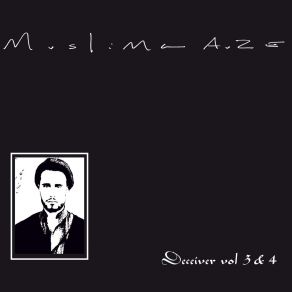Deceiver Vol. 3 & 4
Download links and information about Deceiver Vol. 3 & 4 by Muslimgauze. This album was released in 1996 and it belongs to Ambient, Electronica, Techno, Jazz, Dancefloor, World Music, Dance Pop genres. It contains 21 tracks with total duration of 01:38:43 minutes.

|
|
|---|---|
| Artist: | Muslimgauze |
| Release date: | 1996 |
| Genre: | Ambient, Electronica, Techno, Jazz, Dancefloor, World Music, Dance Pop |
| Tracks: | 21 |
| Duration: | 01:38:43 |
| Buy it NOW at: | |
| Buy on iTunes $19.99 | |
| Buy on Amazon $13.98 | |
| Buy on Songswave €1.47 | |
| Buy on Songswave €1.30 | |
Tracks
[Edit]| No. | Title | Length |
|---|---|---|
| 1. | 100 Great Turks | 4:07 |
| 2. | Persian Silk Damask | 5:28 |
| 3. | Tamburiame Mezzanine | 6:12 |
| 4. | Mamounia | 4:13 |
| 5. | Opulent Baku Cube | 4:57 |
| 6. | Balvinder | 4:11 |
| 7. | Balvinder, Once More | 2:08 |
| 8. | Punjabi Cycle | 3:08 |
| 9. | Egypt, No Plague | 4:05 |
| 10. | Deceiver | 4:44 |
| 11. | Maharajaganjinna | 3:05 |
| 12. | Track One | 8:54 |
| 13. | Track Two | 8:54 |
| 14. | Track Three | 3:42 |
| 15. | Track Four | 8:58 |
| 16. | Track Five | 6:19 |
| 17. | Track Six | 5:37 |
| 18. | Track Seven | 0:30 |
| 19. | Track Eight | 5:12 |
| 20. | Track Nine | 0:31 |
| 21. | Track Ten | 3:48 |
Details
[Edit]Starting off with the quite lengthy first title track, which begins as a heavy-stomp monster that either is sampling a John Bonham drum part or is doing its best to sound like it is, then alternates between quieter and louder passages, Deceiver is another excellent entry in the limited-edition release series begun by Izlamaphobia. Like that other double-disc release, which showcased Bryn Jones moving into newer, less familiar sonic realms with his work, Deceiver has Muslimgauze working in extremis on a variety of fronts, if not quite as much (though pretty darned close nonetheless) as the earlier effort. One thing that definitely does carry over from Izlamaphobia is Jones' love for crunching drum and percussion sounds used in immediate, in-your-face approaches. Standouts in this vein, to name just two out of many, include "A Parsee View," one of the sharpest and most danceable things Muslimgauze released, with a massive beat and tight groove accompanied by what sounds like heavily-amplified clapping, and the very untypical "Herod-1," anchored around a pumped-up series of bass synth lines and a swirling, wordless female vocal sample. "Herod-2" takes the bass and gets even crazier with it, with backwards percussion and many strange twists and turns. The full blend of punch and experimentalism which characterized Izlamaphobia does crop up at points here as well, as with "Morsel of Sand," with several interlocked percussion lines, some quite clear and some heavily treated, accompanied only by a flute, and the body-rocking first "Jagdish Masjid of Light," which even has some wah-wah guitar snuck into the funk. The second "Jagdish" is no slouch either, with distortion and sonic overload worthy of Autechre to boot on top of everything else.